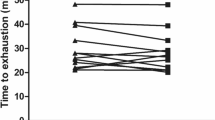Abstract
Thermal sweating from the human torso accounts for about half of the whole-body sweat secretion, yet its intra-segmental distribution has not been thoroughly examined. Therefore, the aim of the current study was to provide a detailed description of the distribution of eccrine sweating within the torso during passively-induced (water-perfusion garment: 40°C) and progressively increasing, exercise-related thermal strain (36°C, 60% relative humidity). Sudomotor function was measured in ten males using ventilated sweat capsules (3.16 cm2) attached to twelve sites on the ventral (four), lateral (three) and dorsal (four) torso, and upper shoulder surfaces. Sweating increased asymptotically in all sites, with the final core temperature averaging 39.7°C (±0.1) and heart rates being 181 b min−1 (±2). During exercise, the mean torso sweat rate averaged 1.35 mgcm−2min−1, with sweating from the lateral torso surfaces generally being the lowest. Each of the between-site comparisons with the lateral torso differed significantly (P < 0.05), except for comparisons with the chest (P = 0.051) and shoulder (P > 0.05). The intra-segmental differences between the lateral torso and the chest, abdomen, upper- and lower-back areas were significantly accentuated during exercise. From these data, it is evident that the torso is another region that does not have a uniform distribution of thermally-induced sweating. Thus, it is no longer acceptable for researchers, modellers, sweating manikins engineers or clothing manufacturers to assume that the sweat rates for all local sites within any body segment are equivalent.



Similar content being viewed by others
References
Cotter JD, Taylor NAS (2005) The distribution of cutaneous sudomotor and alliesthesial thermosensitivity in mildly heat-stressed humans: an open-loop approach. J Physiol 565:335–345
Cotter JD, Patterson MJ, Taylor NAS (1995) Topography of eccrine sweating in humans during exercise. Eur J Appl Physiol 71(6):549–554
Havenith G, Fogarty A, Bartlett R, Smith CJ, Ventenat V (2007a) Upper body sweat distribution during and after a 60 minute training run in male and female runners. In: Mekjavic IB, Kounalakis SN, Taylor NAS (eds) Environmental ergonomics XII. Biomed d.o.o., Ljubljana, pp 270–271. ISBN 978-961-90545-1-2
Havenith G, Fogarty A, Bartlett R, Smith CJ, Ventenat V (2007b) Male and female upper body sweat distribution during running measured with technical absorbents. Eur J Appl Physiol (this issue)
Hertzman AB (1957) Individual differences in regional sweating. J Appl Physiol 10:242–248
Hertzman AB, Randall WC, Peiss CN, Seckendorf R (1952) Regional rates of evaporation from the skin at various environmental temperatures. J Appl Physiol 5:153–161
Hwang K, Baik SH (1997) Distribution of hairs and sweat glands on the bodies of Korean adults: a morphometric study. Acta Anat 158:112–120
ISO 9886 (1992) Evaluation of thermal strain by physiological measurements. International Standard Organisation, Geneva
Kawahata A (1950) Studies on the function of human sweat organs. J Mie Med Coll 1:25–41
Knip AS (1969) Measurement and regional distribution of functioning eccrine sweat glands in male and female Caucasians. Human Biol 41:380–387
Knip AS (1972) Quantitative considerations on functioning eccrine sweat glands in male and female migrant Hindus from Surinam. Proc Kron Ned Akad Wet Ser C 75:44–54
Machado-Moreira CA, Smith FM, van den Heuvel AMJ, Mekjavic IB, Taylor NAS (2007a) Regional differences in torso sweating. In: Mekjavic IB, Kounalakis SN, Taylor NAS (eds) Environmental ergonomics XII. Biomed d.o.o., Ljubljana, pp 293–296. ISBN 978-961-90545-1-2
Machado-Moreira CA, Wilmink F, Meijer A, Mekjavic IB, Taylor NAS (2007b) Local differences in sweat secretion from the head during rest and exercise in the heat. Eur J Appl Physiol (this issue)
Ogata K (1935) Functional variations in the human sweat glands, with remarks upon the regional difference of the amount of sweat. J Oriental Med 23:98–101
Ojikutu RO (1965) Die Rolle von Hautpigment und Schweissdrusen in der Klima-anpassung des Menschen. Homo 16:77–95
Park SJ, Tamura T (1992) Distribution of evaporation rate on human body surface. Ann Physiol Anthrop 11:593–609
Randall WC, Hertzman AB (1953) Dermatomal recruitment of sweating. J Appl Physiol 5:399–409
Roberts DF, Salzano FM, Willson JOC (1970) Active sweat gland distribution in Caingang Indians. Am J Phys Anthrop 32:395–400
Szabo G (1962) The number of eccrine sweat glands in human skin. Adv Biol Skin 3:1–5
Szabo G (1967) The regional anatomy of the human integument with special reference to the distribution of hair follicles, sweat glands and melanocytes. Phil Trans Roy Soc Lond Ser B 252:447–485
Taylor NAS, Caldwell JN, Mekjavic IB (2006) The sweating foot: local differences in sweat secretion during exercise-induced hyperthermia. Aviat Space Environ Med 77:1020–1027
Taylor NAS, Machado-Moreira CA (2007) Regional differences in human eccrine sweat secretion following thermal and non-thermal stimulation. In: Mekjavic IB, Kounalakis SN, Taylor NAS (eds) Environmental ergonomics XII. Biomed d.o.o., Ljubljana, pp 266–269. ISBN 978-961-90545-1-2
Taylor NAS, Patterson MJ, Cotter JD, Macfarlane DJ (1997) Effects of artificially-induced anaemia on sudomotor and cutaneous blood flow responses to heat stress. Eur J Appl Physiol 76:380–386
Thompson ML (1954) A comparison between the number and distribution of functioning eccrine glands in Europeans and Africans. J Physiol 123:225–233
Weiner JS (1945) The regional distribution of sweating. J Physiol 104:32–40
Willis I, Harris DR, Moretz W (1973) Normal and abnormal variations in eccrine sweat gland distribution. J Invest Derm 60:98–103
Acknowledgments
This project was supported, in part, by a grant from the Ministry of Defence (Republic of Slovenia). It was also supported by a Doctoral scholarship from Coordenação de Aperfeiçoamento de Pessoal de Nível Superior - CAPES (Ministry of Education, Brazil).
Author information
Authors and Affiliations
Corresponding author
Rights and permissions
About this article
Cite this article
Machado-Moreira, C.A., Smith, F.M., van den Heuvel, A.M.J. et al. Sweat secretion from the torso during passively-induced and exercise-related hyperthermia. Eur J Appl Physiol 104, 265–270 (2008). https://doi.org/10.1007/s00421-007-0646-x
Accepted:
Published:
Issue Date:
DOI: https://doi.org/10.1007/s00421-007-0646-x




